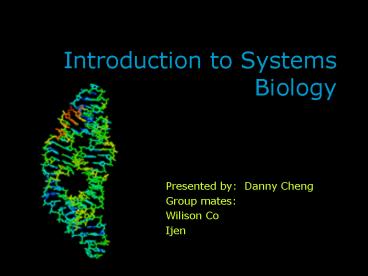Introduction to Systems Biology PowerPoint PPT Presentation
1 / 35
Title: Introduction to Systems Biology
1
Introduction to Systems Biology
- Presented by Danny Cheng
- Group mates
- Wilison Co
- Ijen
2
Topics to be discussed
- What is Systems Biology?
- Properties of Systems Biology
- Methodologies and Techniques to understand
Systems Biology - Systeome Project
- Impact of Systems Biology
- Conclusion
3
What is Systems Biology?
- Is a new field in biology that aims at
system-level understanding of biological systems.
Hiroaki Kitano - Question is, what do we mean by biological
systems? - By system, we mean a bunch of parts that are
connected to one another and work together.
Jeff Shrager
4
What are biological systems?
- Ranges from ecosystems to the system of reactions
that form cellular biochemistry. - Usually, we refer to the latter systems of
biochemical reactions that make cells work.
5
Biological System Sample
6
Biological System Sample
7
A bigger picture of Systems Biology
8
Organizational and Descriptional Levels
9
Why do we care about biological systems?
- Ability to figure out what the effect will be of
an intervention in one part of the system - What intervention one has to make in order to
obtain some desired result - Meaning (Example) Which protein should be either
activated or deactivated in order to stop a
particular disease process while doing the least
harm to the patient?
10
Where do computers come in?
- Systems modeling
- Systems simulation
- Systems reasoning
- Systems discovery
11
Properties to be investigated
- Structure of the systems
- The dynamics of such systems
- Methods of control systems
- Methods to design and modify for desired
properties
12
Measurement Technologies and Experimental methods
- Towards comprehensive measurements
- Factor comprehensiveness
- Time-series comprehensiveness
- Item comprehensiveness
13
Next Generation Experimental Systems
- Better automation to produce high throughput
experiments - The use cutting-edge technologies such as
micro-fluid systems, nano-technology and
femto-chemistry in developing next-generation
experimental devices.
14
System Structure Identification
- In order to understand a biological system, we
must first identify the structure of the system. - The difficulty is that such a network cannot be
automatically inferred from experimental data
based on some principles or universal rules,
because biological systems evolve through
stochastic processes and are not necessarily
optimal.
15
Network Structure
- Bottom-up approach
- tries to construct a gene regulatory network
based on the compilation of independent
experimental data - This approach is particularly suitable for the
end-game scenario where most of the pieces are
known and one is trying to find the last few
pieces
16
Network Structure
- Top-down approach tries to make use of
high-throughput data using DNA microarray and
other new measurement technologies - Most of the methods developed in the past
translate expression data into binary values, so
that the computing cost can be reduced. However,
such methods seriously suffer from information
loss in the binary translation process, and
cannot obtain the accurate network structure.
17
Microarray Bioinformatics
18
Parameter Identification
- It is important to identify only the structure of
the network, but a set of parameters, because all
computational results have to be matched and
tested against actual experimental results.
19
System Behavior Analysis
- Once we understand the structures of the system,
research will focus on dynamic behaviors of the
system. - How does it adapt to changes in the environment,
such as nutrition, and various stimuli?
20
System Behavior Analysis
- Simulation
21
System Behavior Analysis
22
SBML
- a description language for simulations in systems
biology - meant to support non-spatial biochemical models
and the kinds of operations that are possible in
existing analysis/simulation tools
23
Future of SBML
- Arrays
- Connections
- Database Interoperability
- Geometry
- Submodels
- Component Identification
- References
- Diagrams
24
SBML
25
System Behavior Analysis
- Analysis methods
- bifurcation analysis
- metabolic control analysis
- sensitivity analysis.
26
Gene Expression and Regulation
27
Intra- and Inter-Cellular Dynamics
28
Robustness of Biological Systems
- System control
- Redundancy
- Modular Design
- Structural Stability
29
Heat-Shock Regulation
30
The SYSTEOME Project
- Systeome is an assembly of system profiles for
all genetic variations and environmental stimuli
responses. - Systeome is different from a simple cascade map.
- Goal to complete a detailed and comprehensive
simulation model of the human cell at an
estimated error margin of 20 by year 2020, and
to finish identifying the system profile for all
genetic variations, drug responses, and
environmental stimuli by 2030.
31
Impact of Systems Biology
- Combined with genomic and other projects, it may
have major impacts on medical research and
practice. - In-depth knowledge of dynamical state of cells
and development of high-performance measurements
will drastically change medical practice.
32
Refer to IBMs Slides
PDF File
33
Conclusion
- System biology is a new and emerging field in
biology - A long ways to go before understanding biological
systems - Nevertheless, the author believes that systems
biology will be the dominant paradigm in biology,
and many medical applications as well as
scientific discoveries are expected Hiroaki
Kitano
34
Vielen Dank für das Hören
Fragen?
35
Thank you very much for listening
Questions?

